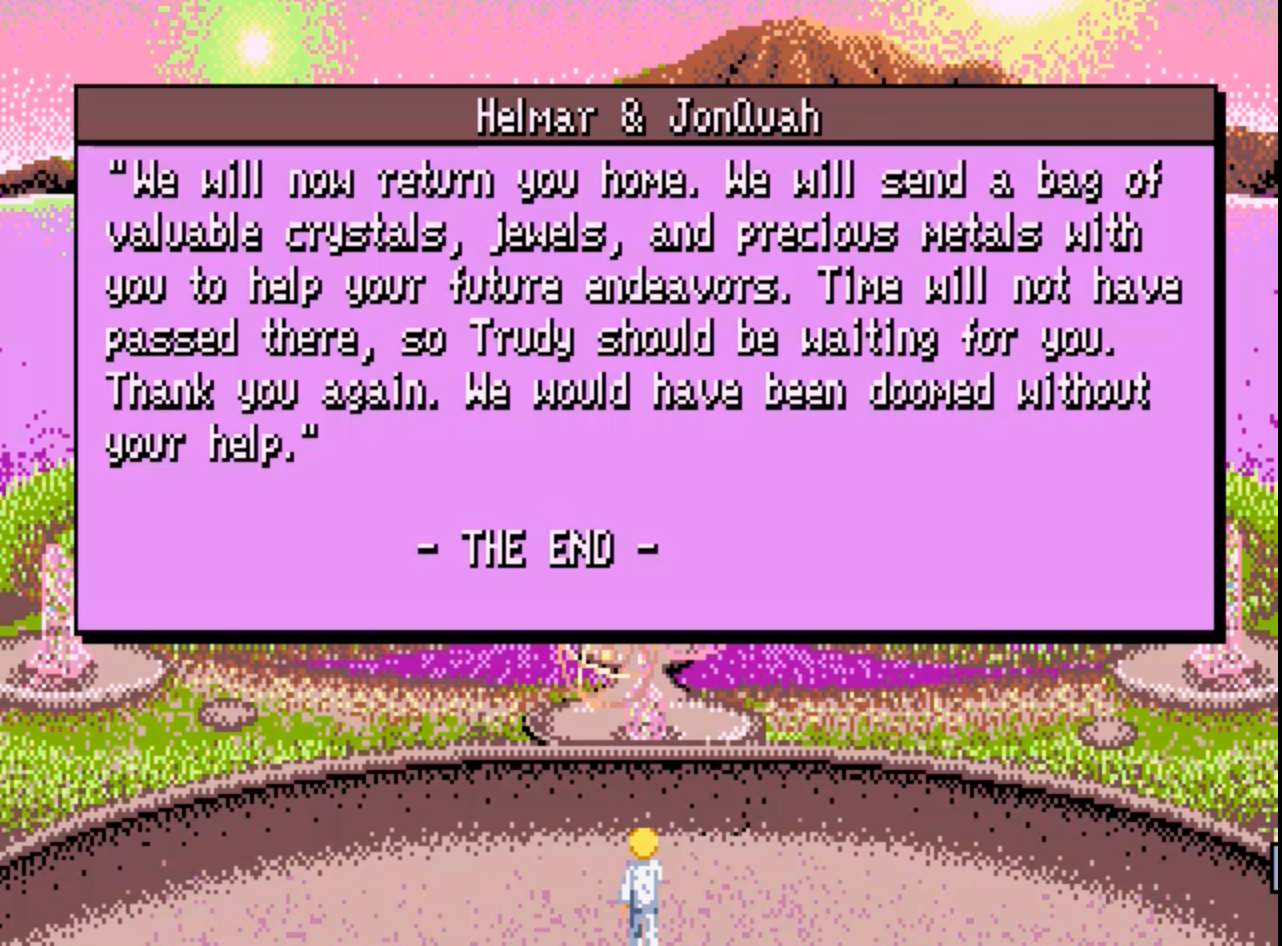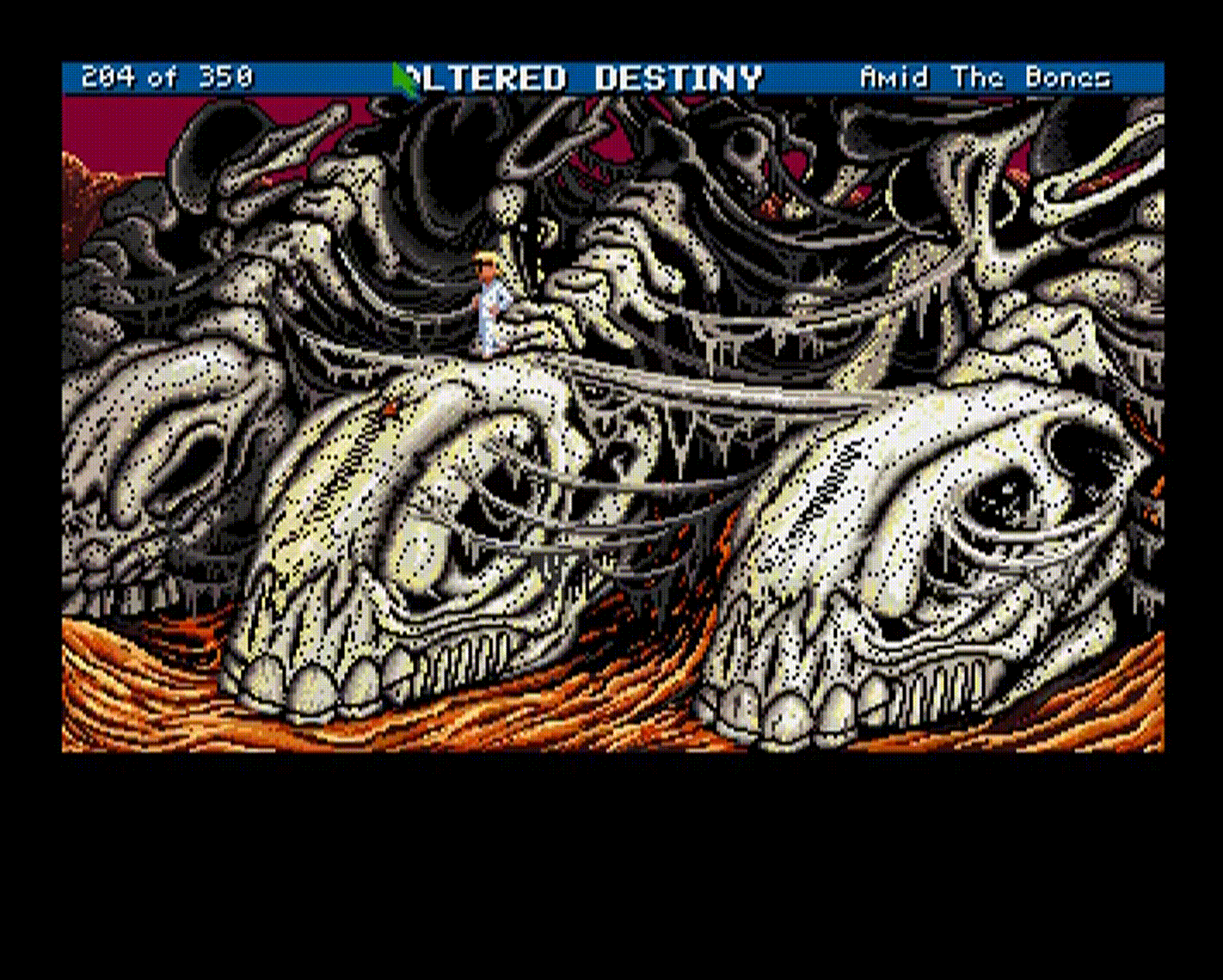Altered Destiny (Accolade) - 1990
Series: Let's Adventure! A Journey into Adventure Games (1980-1999)This review is part of the Let's Adventure! series. See all reviewed games sorted by rating here.
- ← Flight of the Amazon Queen (Interactive Binary Illusions) - 1995
- Altered Destiny (Accolade) - 1990
- → Discworld (Teeny Weeny Games/Perfect 10 Productions) - 1995
Article 81 of 101 in this series.
Altered Destiny is a graphic adventure game released by Accolade in 1990 for MS-DOS compatible operating systems and in 1991 for Amiga. The game was designed by Michael Berlyn and it uses a text parser interface. It is the second adventure game from Accolade and it uses the same engine as the first one, Les Manley in: Search for the King.
One fine day P. J. Barrett, an ordinary human being from the planet Earth, goes to a repair shop to get his TV set fixed. When he comes back for it, he accidentally picks up the wrong one. No big deal? Quite on the contrary. When the unsuspecting Mr. Barrett returns home and turns the TV on, he is sucked into a portal! One moment later, he finds himself on the strange planet of Daltere. Naturally, this planet needs a savior: the evil alien Helmar has stolen an artifact known as the Jewel of Light, thus endangering the entire galaxy. Now our unlikely hero has to overcome various obstacles and save the world.1
I never owned an Amiga when I was growing up, though my uncle had one as he was a graphic artist and I guess back in the mid 80s to early 90s this was the system to use - and Deluxe Paint was all the rage.
This wasn’t a system I really got to mess around with (it was a “work” computer), but the odd game I was exposed to I remember having impressive graphics and sound.
Since one of my goals for this retrospective journey is to try and experience as many of these games on as many (emulated) systems as possible, I wanted to make sure I play through a few of these titles on the Amiga.
As soon as you insert disk one and boot the game up you’ll be met with a copy protection screen. I tried to find a copy of the manual online, but failed. Even the game’s entry in the Games Database didn’t have anything for me, so I chose to resort to “alternate” means of bypassing this barrier.
It turns out what I needed was the code wheel that could be found at the museum of computer adventure game history, but I found this after I’d finished the game already …
 I’m guessing Accolade won’t mind that I’m emulating a cracked version of the game 30+ years after it came out
I’m guessing Accolade won’t mind that I’m emulating a cracked version of the game 30+ years after it came out
I ended up playing the Skid Row cracked release of the game, which will accept any input on the challenge screen and allow you to progress. Though there are obviously good arguments for why software piracy is bad, when looked at through the lens of digital preservation and making historic content accessible to future generations of players I appreciate the work that these groups put in.
Altered Destiny uses a similar engine to Sierra’s first iteration of the SCI engine (SCI0) as it support basic character navigation with the mouse, but all other interaction with the game world was done using a text parser.
The most common verb you’ll use is LOOK, which will typically give you a lot of information about the screen you’re on, including characters (with their names) you can interact with, items you might be able to pick up and other useful details.
There are several alien creatures to talk to. Whenever you LOOK on a screen the game helpfully tells you the name of the alien there, so it’s easy enough to know who to TALK to. You then need to ASK ABOUT various topics to learn what to do next or uncover more of the plot.
You’ll want to take notes as these interactions will usually surface the names of other characters you’ll want to seek out, and you’ll want to ask each alien creature about the others that you’ve met or learned about.
Similar to Sierra games at the time, path finding for your character was challenging and would typically result in you falling to your death. I found several times that I’d need to resort to using the mouse to click on a target I wanted PJ to walk to as it would usually get me there safely … but occasionally you were better off using the direction keys on the keyboard.
There’s also only one message ever shown when you die, so it’s not interesting to explore the different ways the environment will end your adventure because you see the same thing regardless of what you do.
 I do not miss the days of multi-disk games
I do not miss the days of multi-disk games
You’ll want to save often, but Amiga games required a save disk to be swapped in in order for this to occur. I played this game using vAmiga, so I could just use save states which are exponentially more convenient than having to swap the save disk in, save, then swap the current game disk in.
Disk access times seriously slow down the game play experience. I don’t know if it’s due to just not having enough experience tuning an Amiga emulator, but I can safely say that 70% of my play time was spent just waiting for the disks to finish spinning.
It was also frustrating when I’d swap disks (as requested) too quickly, so I’d have to put the previous disk back in, let it read, wait for the prompt, switch and try again. SO. MUCH. WAITING.
 This map screen makes the game world feel bigger than it really is
This map screen makes the game world feel bigger than it really is
The game world in Altered Destiny is actually fairly small, but once you get down from the floating island and reach the cross roads you’ll get a map screen that shows PJ progressing between the various game areas.
Examining your inventory items or various things on screen will bring up a more detailed view that provides additional information. This was particularly useful in helping to identify what might be more important to interact with as the game designers were clearly trying to draw your attention to these.
Like Sierra games of that era, it’s extremely easy to miss picking up key items and you can find yourself in unwinnable situations requiring you to restore to much earlier saves or restart entirely.
This happened to me a couple times, which almost lead me to abandon this playthrough simply because I didn’t want to have to endure the disk access and screen loading times I knew came with back tracking.
Items you can pick up are typically fairly obvious, and when they’ve been picked up they’re no longer visible on screen. I appreciate this as it makes the game world feel a bit more interactive as your actions are affecting the world around you.
Whenever there are item combination puzzles though some of the sequences of commands you need to enter can be a bit unintuitive - especially if you were a kid playing this game initially.
For example, to catch the bird here you need to DROP CAGE, then SET THE TRAP, BAIT THE CAGE WITH PIGMENT and wait for the bird to take the bait before you GET CAGE. I’m sure the game designers thought they were setting you up for success with some of the clues leading up to this point, but I found myself reaching for the walkthrough pretty quickly.
To mix up the gameplay a bit there’s one random fight sequence where you need to WIELD SWORD and knock some creature off a floating platform (hopefully you didn’t forget to pick the sword back up after dropping it much, much earlier).
This is an interesting diversion but since you only do it once and there’s really no setup for it it sort of feels forced and unintuitive. You sort of just have to keep mashing right on the directional pad until you knock the creature into the pool of light, then you need to fall off the platform into the pool as well (I can’t remember why anymore).
The final battle with Helmar boils down to just picking the right option from a menu. Spoiler: it’s the mirror. When you do this you reflect the beam he shoots back at him, killing him and freeing the world and restoring the jewel of light to its rightful place in the universe (I think that’s what happens at least).
 Error 19, then crash back to the OS
Error 19, then crash back to the OS
For the first time in this series I didn’t actually finish the game myself and take a “THE END” screenshot … because the game crashed after defeating Helmar. Maybe this is an emulation issue, maybe it’s an issue with the game having been cracked by Skid Row and this being a checksum failure or some other protection measure.
 This is a screenshot from a longplay on YouTube because my game crashed right at the end
This is a screenshot from a longplay on YouTube because my game crashed right at the end
I technically finished the game and have zero desire to play it again using the MS-DOS version, so I cheated and swiped the last screenshot from a longplay video.
Altered Destiny has some good graphics and sound, but it’s not really adding anything to the experience that other games released at that time were. The story seems a little forced, the inventory puzzles are sort of frustrating and there’s really not much to do.
It’s entirely possible I would have enjoyed the MS-DOS version more (assuming the load times are greatly improved), but Altered Destiny plays like an over-complicated Space Quest clone without any of the humor.
Game Information
| Game | Altered Destiny |
| Developer | Accolade |
| Publisher | Accolade |
| Release Date | 1990 |
| Systems | Amiga, DOS |
| Game Engine |
My Playthrough
| How Long To Beat? | 6.5 hours |
| Version Played | Amiga via vAmiga |
| Notes | Walkthrough |
Score
See here for a refresher on how we’re scoring these games.
| Atmosphere (20) | 8 |
| Story (25) | 8 |
| Experience (15) | 5 |
| Impact (10) | 3 |
| 34% |
Gallery
Footnotes
Description from Moby Games ↩︎










